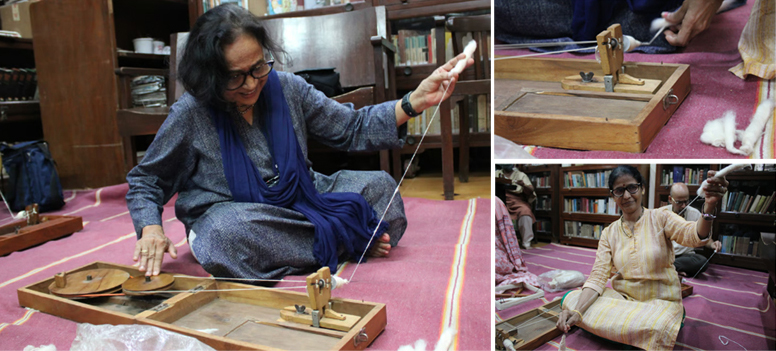
Some men changed their times...
One man changed the World for all times!
Comprehensive Website on the life and works of
Mahatma Gandhi
+91-23872061
+91-9022483828
info@mkgandhi.org

+91-23872061
+91-9022483828
info@mkgandhi.org
Spinning for Healing: Decoding How Charkha Is Turning Into A Powerful Tool Of Self-HealingAhead of Gandhi Jayanti, decoding how charkha is turning into a powerful tool- By Minal Sancheti Take to spinning to find peace of mind. The music of the wheel will be as balm to your soul. I believe that the yarn we spin is capable of mending the broken warp and woof of our life. - Mahatma Gandhi Charkha is more than an instrument through which we convert a mere cotton roll or punis into a yarn. “It’s a symbol of nonviolence because there’s no electricity used, there’s no animal cruelty and it’s hand made. This is a gift from Gandhiji to our country,” says Bhargavi Seth, one of the practitioners and a charkha student at Mani Bhavan. Gandhiji associated spinning charkha as a way to connect God. Many practitioners of charkha agree to it till today. “When you learn using charkha, you get a lot of mental peace,” says Rajashri Choche, an accountant by profession and a full time charkha teacher from the past 20 years teaching at Mani Bhavan. She teaches Khadi as a subject at Shishuvan School, Matunga. Choche was a part of Bombay Sarvoday Mandal where she took up the initiative of learning charkha, “There I met Eli Gadkar and other social workers, who taught me charkha for three to four months. They practised it religiously and made their own clothes. They wanted to pass on the skill of teaching charkha to someone so they asked me. Initially, I learnt using the takli and then charkha.” This humble tool has a deeper meaning which makes it a symbol of nonviolence. As many practitioners till today believe that even half an hour every day can be beneficial to mental peace. “Spending even half an hour or one hour can help the practitioner relax and improve concentration. Practising charkha requires the person to align their mind, body and heart which in return helps them concentrate better and release stress,” says Avani Varia, a heritage professional and artist for the past two decades, working on preserving the local art of various regions of India, especially Gujarat. She started teaching charkha from Mahatma Gandhi’s first Satyagraha Ashram at Kochrab, Ahmedabad and reached one lakh learners till today. Along with a calming effect the tool also helps improve concentration. “A school in Nagpur started teaching charkha to their students and that helped them improve their concentration, so I also wanted to learn,” says Santosh Vartak, a charkha student at Mani Bhavan. Santosh wishes to teach the skill to her daughter who is a special child. MeditativeCharkha gives you a feeling of independence. “The process is meditative. It gives you a state of thoughtless mind. You are decluttered on the thought level, and you can think with clarity, independently,” says Sunanda Kalve, a handwork teacher. Spinning Charkha and making threads takes a lot of time and patience. “Unless you do it, you will not understand the process. It helps learn the processes involved from a fibre state to the finished fabric. It keeps us away from instant gratification. However, the khadi cloth is healing and it keeps us healed as per the climate. It is cool in summer and warm in winter. Every handmade craft will take time and also allows you to be in the moment. It also helps remove knots within while removing knots outside,” says Kalve. Yarn is a by-product of using charkha. “The current lifestyle is very stressful and people in urban regions require something to unwind and relax; charkha is a perfect tool to help in this situation,” says Avani Varia, who has been associated with NGOs and have initiated 'Chalo Charkho Ramiye' India's contemporary charkha movement. Spinning charkha teaches you patience, “I have been learning for the past three years. I got a chance to visit juvenile jail along with a teacher from here at Mani Bhavan. The children at jail are aggressive. They at times even harm themselves. I noticed they became a lot calmer after practising charkha. It was a challenge to get them to learn charkha, but we told them about the history of the art and how it was part of the Swadeshi Movement. We are trying to reach out to special children's schools,” said Neha Joil, a lawyer, researcher and charkha student. InclusiveThe tool is considered to be inclusive and affordable for all. “Charkha is easy to learn by people of all ages and any social background. People with special abilities can also spin thread with takli / charkha. These traditional tools can bring income to the poorest of poor with very limited resource investment,” says Varia. She talks about how the tool holds a religious purpose, “Traditionally ‘Janoi’ the sacred thread was made using hand spun yarn with takli. During my visit to Varanasi, I came across elderly women who still today make the wick of diyas using takli.” When using charkha when you are concentrating well, the threads become thin and fine, says Sandhya Mehta, a charkha student and whose grandfather was a participant of Salt Satyagraha led by Gandhiji in 1930. “Gandhi could weave fine yarn. He wove saris for his wife. If you’re stressed your thread will break and you won’t be able to weave properly. There’s something magical about charkha,” she signs off. Courtesy: Free Press Journal, dated September 29, 2024. |